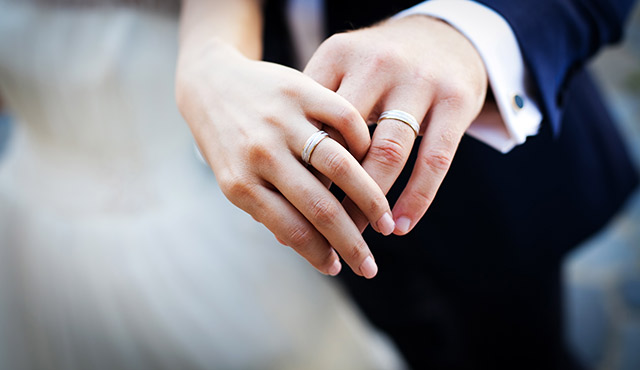There is something old and also something new in the Order of Christian Matrimony, the latest updated version of the wedding ritual in the Catholic Church.
“The new ritual gives us an expanded theological reflection in the introduction to the ritual text that will allow priests and those in ministry to offer couples additional insights and avenues to enrich the celebration of matrimony and marriages,” says Lesa Truxaw, director for the Diocese’s Office for Worship. All parishes in the United States must begin implementing the changes by December 30, 2016.
The first major change is the title of the ritual itself – the Order of Christian Matrimony. It used to be referred to as the Rite of Marriage.
“The distinction is that the ritual itself is called the Rite of Matrimony. That’s for the celebration itself. Marriage is what happens from that day on,” explains Father Troy Schneider, who works with Truxaw to offer workshops to those in the diocese involved in the marriage preparation ministry and educate them on the changes to the ritual.
The new ritual also includes an expanded Praenotanda, or opening rites. The old version had 18 paragraphs. The new ritual has 44 paragraphs that give a deeper explanation of the theology of marriage.
“It describes the dignity and importance of the sacrament of matrimony,” says Father Schneider. “In addition to that, the regular readings that are offered for the rite of matrimony have also been expanded.”
The new ritual also gives music a bigger role in the celebration of matrimony.
“There is a lot more influence in music being involved,” says Fr. Schneider. “They’ve included areas for music in the community to sing together besides just the introduction, communion and the dismissal. Now there are other places for music.”
Another major change is the cultural adaptations in the English version of the rite. This includes the blessing or giving of the arras, or coins, and the blessing of the lazo, or veil. Although this has already been in practice for several years in the Spanish version of the rite for use in the United States, it is now officially offered as an option for couples in the English version.
“This would help for those celebrations where they might be two cultures coming together or for the younger people who aren’t as comfortable in Spanish and want to be able to celebrate the ritual in English but find the culture a rich expression of what they wish their marriage to be like,” explains Truxaw.
The exchange of coins represents that the couple now shares everything and the veil placed upon the bride and the groom symbolizes their union.
The most significant change is the emphasis on pastoral care in preparation for marriage and the sacrament of matrimony.
“It puts a lot of emphasis on the people preparing — priests, deacons or lay ministers — who are preparing the couple,” says Father Schneider. “For example, it speaks of the necessity of proper marriage preparation for the bride and groom, speaking on the dignity of marriage, the need for prayer together, the need for explaining that they are entering into a covenant, versus a contract. The emphasis that marriage is a covenant that lasts your whole life.”
The Diocese requires couples to first contact their parish six months to one year prior to their wedding date. Once approved, the priest or deacon will meet with them several times before their wedding date. The couple is also required to attend one of the marriage preparation programs offered by their parish.
Michael Donaldson, director of the Diocese’s Office of Pastoral Care for Families in All Stages, which oversees all of the marriage preparation programs, formed a committee to help him take marriage preparation a step further.
“We want to be more intentional at an earlier stage in life. We are trying to see how we can revitalize our marriage ministries and really realize that we are waiting too late for marriage prep,” he says. “The new marriage preparation, the marriage preparation that we should be doing is building up our current marriages because our wives and our husbands, our mothers and fathers really are the first teachers of what a true and healthy marriage looks like to children. So if children can learn those virtues within a healthy family, then that will carry on, and then we can be more intentional with our religious education and faith formation programs and we hope that by the time they actually get to the marriage preparation class, they would have already developed those virtues so that what we would be doing is just solidifying what they’ve already been informed in.”
There are several marriage preparation programs to choose from. The programs cover topics such as healthy sexual intimacy, communication, understanding marriage as a covenant, to name a few.
“Some of that theology is really important because it helps set the tone for their journey together,” explains Donaldson.

